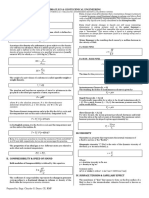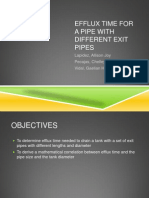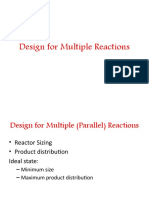Expt Guide A2 - Efflux Time
Expt Guide A2 - Efflux Time
Uploaded by
ariana religiosoCopyright:
Available Formats
Expt Guide A2 - Efflux Time
Expt Guide A2 - Efflux Time
Uploaded by
ariana religiosoOriginal Description:
Copyright
Available Formats
Share this document
Did you find this document useful?
Is this content inappropriate?
Copyright:
Available Formats
Expt Guide A2 - Efflux Time
Expt Guide A2 - Efflux Time
Uploaded by
ariana religiosoCopyright:
Available Formats
University of Santo Tomas
Faculty of Engineering
Department of Chemical Engineering
Experiment A2:
Efflux Time for a Tank with Different Exit Pipes
1. OBJECTIVES
1.1 To determine the efflux time needed to drain a tank with a set of exit pipes with different
lengths and diameters.
1.2 To derive a mathematical correlation between the efflux time and the pipe size and the tank
diameter.
2. THEORY
Pipe flows may be classified either as a laminar or turbulent. In laminar flow, the fluid rate is
maximum at the pipe axis and eventually decreases to zero at the pipe wall while in turbulent flow,
the velocity distribution is more uniform across the pipe diameter [1]. In terms of the dimensionless
number, Reynolds Number (NRe), laminar flow occurs at NRe 2,100 while turbulent flow occurs at
NRe 4,000. In a case where any of the two situations mentioned is not strictly observed, the flow
is said to be transitional [2].
As the fluid enters one end of the pipe, the velocity distribution in the radial direction up to a
certain length of the pipe cannot be classified under any of the classification mentioned earlier.
However, as the fluid continues to flow, the velocity distribution becomes more defined. At the
point, the flow is said to have reached the “fully developed” stage. The length of the pipe that is
necessary to achieve the fully developed stage is called the “entry length” or “entrance length”, Le.
It is the length wherein the boundary layers grow in thickness and meet at the center of the pipe [2],
thus creating a well-defined velocity profile. Typical entrance lengths are given by:
Le 0.06DNRe for laminar flow and
Le 4.4D NRe
1
6 for turbulent flow.
3. EQUIPMENT/MATERIALS
Efflux time apparatus distilled water
calibrated pail glycerol
stopwatch ruled tape
4. SAFETY
Make sure that the tank is properly mounted before starting the experiment. If the tank is not
fastened properly to the rack, wrong calculations may result due to the inaccurate water level. The
pipe to be used must be tightly sealed to the tank to avoid leakage during the operation. Since the
liquid spillage is impossible to avoid, it must be controlled at any time to avoid accident due to
spillage on the floor.
5. PRELIMINARY
5.1 Using the viscometer/viscotester, measure the viscosity of water and 50% glycerol-water
mixture. Record the temperature of the mixture when measuring the viscosity.
5.2 Prepare the preliminary calculations before the start of the experiment. (Refer to the Section
2 of this text.)
ChE 424L: Chemical Engineering Laboratory I |Experiment Guide 1|Page
Experiment A2: Efflux Time for a Tank with Different Exit Pipes
6. OPERATING PROCEDURE AND CONDITIONS
6.1 Start-Up
6.1.1 Prepare 3.5 L of water and 3.5 L of 50% glycerol in separate containers.
6.1.2 Obtain the dimensions of the tank and the pipes.
6.1.3 Have a stopwatch ready.
6.2 Experimental Procedure
6.2.1 Cover the orifice of the tank with your hand. Slowly pour the water into the tank until
it is full.
6.2.2 Note the time it takes to empty the tank.
6.2.3 Attach pipe 1 to the tank orifice. Cover the orifice of the pipe with your hand and fill
the tank with water.
6.2.4 Allow at least 1 minute before draining the tank. Record the times at which the liquid
level passes height intervals of 2 cm as seen at the level view port. Determine the efflux
time. Make three trials.
[NOTE: Efflux time is the time necessary to empty the tank alone]
6.2.5 Repeat steps 6.2.3 to 6.2.4 for each pipe size.
6.2.6 Repeat steps 6.2.1 to 6.2.5 using glycerol solution as the liquid sample.
6.3 Shutdown
6.3.1 Be sure to clean the tank and the pipes properly by allowing soap and water to run
trough these parts.
6.3.2 Clean the working area. Make sure that the area is dry and not sticky.
Finally, is everything TIDY and SAFE?
7. TREATMENT OF RESULTS
7.1 Tabulate the data following the given format below:
Pipe No. Diameter Length Height Average Time NRe Le
Interval Velocity
: : : : : : : :
: : : : : : :
7.2 Calculate the theoretical average linear velocity ( u ), entry length (Le) and the efflux time (teff).
7.3 Plot the height interval vs. time based on the experimental results.
7.4 For exit pipes of equal lengths, plot Le vs. D/d (ratio of the diameter of the tank to that of the
exit pipe) based on the experimental results.
7.5 For exit pipes of equal diameters, plot Le vs. L/D (ratio of the exit pipe length to tank diameter)
based on the experimental results.
7.6 Plot teff vs. L/D and teff vs. D/d based on experimental and theoretical results.
8LR 2 H
t eff ln 1 for laminar flow
gR 0
4
L
5LR 2 H
t eff ln1 for turbulent flow
gR 0
4
L
where: L = length of the exit pipe
R0 = inside radius of the exit pipe
R = inside radius of the tank
H = height of the tank
ChE 424L: Chemical Engineering Laboratory I |Experiment Guide 2|Page
Experiment A2: Efflux Time for a Tank with Different Exit Pipes
8. ANALYSIS/INTERPRETATION OF RESULTS
8.1 Interpret the graphs obtained.
8.2 By statistical analysis, derive a mathematical equation that relates efflux time with the pipe size
and the diameter of the tank.
8.3 How do you explain the discrepancies between the theoretical and the actual efflux time
obtained?
8.4 How does vorticity at the surface affect efflux time?
9. QUESTIONS
9.1 Give practical applications of the principle of efflux time. What areas of chemical engineering
can we apply this concept?
9.2 In cases where there is a desired efflux time, what design considerations must be specified?
10. REFERENCES
[1] Munson, B. R., Young, D. F., and Okiishi, T. H., Fundamentals of Fluid Mechanics, 3rd ed., John
Wiley and Sons, Inc., 1998.
[2] Papanastasiou, T. C., Applied Fluid Mechanics, Prentice-Hall, Inc., 1994.
[3] Bird, Robert Byron, Stewart and Lightfoot, Transport Phenomena. New York: John Wilet and
Sons, Inc., 1924.
[4] Foust, Alan S., et. Al., Principles of Unit Operations, 2nd ed., New York: John Wiley and Sons,
Inc., 1980.
[5] McCabe, Warren L., Julian C. Smith and peter Harriott, Unit operations of Chemical
Engineering, 5th Ed. New York: McGraw –Hill Book Co., Inc., 1980.
[6] Perry, Robert and Green, D., Perry’s Chemical Engineer’s Handbook, 6th ed., McGraw-Hill, Inc.,
1984.
ChE 424L: Chemical Engineering Laboratory I |Experiment Guide 3|Page
You might also like
- Fundamentals of Fluid Mechanics (Solutions Manual)Document1,327 pagesFundamentals of Fluid Mechanics (Solutions Manual)mariocontigo82% (156)
- HGE Formulas - GilleDocument23 pagesHGE Formulas - GillePENDON, JORELLENo ratings yet
- Solid-Liquid Extraction Leaching: ChapterDocument15 pagesSolid-Liquid Extraction Leaching: Chapterاحمد حمید کارسول عزیزNo ratings yet
- Distillation of Binary LiquidsDocument11 pagesDistillation of Binary LiquidsVanessa Denise AguilarNo ratings yet
- Experiment No. 1 CpiDocument24 pagesExperiment No. 1 CpiIan KoNo ratings yet
- Initial Concentration of NaOH in Feed VesselDocument2 pagesInitial Concentration of NaOH in Feed VesselZeenat RanaNo ratings yet
- Absorption of Carbon Dioxide Into WaterDocument11 pagesAbsorption of Carbon Dioxide Into WaterEstelle Jean CauilanNo ratings yet
- SEPAAAAADocument2 pagesSEPAAAAAAGEO JUSTINE ANGELESNo ratings yet
- Expt. 3 - Efflux Time (Prelaboratory)Document30 pagesExpt. 3 - Efflux Time (Prelaboratory)UKissMeow100% (2)
- Cre 1 IntroductionDocument4 pagesCre 1 IntroductionEvangeline LauNo ratings yet
- Efflux Time For A Pipe With Different ExitDocument17 pagesEfflux Time For A Pipe With Different ExitChelley Sharleene PecajasNo ratings yet
- Distillation LabDocument18 pagesDistillation LabWong XimeiNo ratings yet
- Gas AbsorptionDocument33 pagesGas Absorptionirfan hilmanNo ratings yet
- Design For Multiple ReactionsDocument43 pagesDesign For Multiple Reactionsmuhammad shahadat awanNo ratings yet
- Simple Batch Distillation PracticalDocument10 pagesSimple Batch Distillation PracticalPraveen SharmaNo ratings yet
- Liquid Diffusion CoefficientDocument15 pagesLiquid Diffusion CoefficientmuhdfadzlihadiNo ratings yet
- CHE504 - Lab Report On Distillation ColuDocument27 pagesCHE504 - Lab Report On Distillation ColuMuhammad Irfan MalikNo ratings yet
- Distillation Written ReportDocument18 pagesDistillation Written ReportMaRiz BalitaanNo ratings yet
- Lab 1.1 Theory - Reaction Kinetic Studies in A Batch ReactorDocument3 pagesLab 1.1 Theory - Reaction Kinetic Studies in A Batch ReactorCARL VINCENT SORIANONo ratings yet
- What Is The Difference Between Diffusion and Radiation Heat TransferDocument9 pagesWhat Is The Difference Between Diffusion and Radiation Heat TransferKhalid AlmashikhiNo ratings yet
- Batch ReactorDocument4 pagesBatch ReactorFoo Xiao BingNo ratings yet
- Fluid Flow Through Packed BedDocument9 pagesFluid Flow Through Packed BedAmartya MitraNo ratings yet
- Absorption in PackedDocument21 pagesAbsorption in PackedfreakameNo ratings yet
- Chapter 3 - Stage and Continuous Gas-Liquid Separation ProcessesDocument46 pagesChapter 3 - Stage and Continuous Gas-Liquid Separation Processesomarfhassan0% (1)
- Tutorial 5Document3 pagesTutorial 5pleco4meNo ratings yet
- DISTILLATION UNIT 1 28.2.22 - WatermarkDocument26 pagesDISTILLATION UNIT 1 28.2.22 - WatermarkHardik ChauhanNo ratings yet
- IYOHA COLLINS 16CF020531 Batch Reactor ReportDocument19 pagesIYOHA COLLINS 16CF020531 Batch Reactor ReportDavid OvieNo ratings yet
- Chapter 4Document43 pagesChapter 4aliNo ratings yet
- 02 ChE421 - Flash DistillationDocument4 pages02 ChE421 - Flash DistillationAllyana Marie Tiemsim0% (1)
- Drying ExperimentDocument10 pagesDrying ExperimentKris Dominic RubillosNo ratings yet
- Definition of Mass TransferDocument6 pagesDefinition of Mass TransferBruno Lupi Barroso50% (2)
- CSTR ManualDocument11 pagesCSTR ManualMelly FulaNo ratings yet
- Climbing Film EvaporatorDocument8 pagesClimbing Film EvaporatorPelin Yazgan BirgiNo ratings yet
- VLE ReportDocument4 pagesVLE ReportAmeerul AhwazNo ratings yet
- Experiment 4: Gas AbsorptionDocument25 pagesExperiment 4: Gas AbsorptionLulav BarwaryNo ratings yet
- Fixed Bed and Fluidized BedDocument33 pagesFixed Bed and Fluidized Bedشاكر العاقلNo ratings yet
- Liquid Phase Chemical Reactor FinalDocument38 pagesLiquid Phase Chemical Reactor FinalToMemNo ratings yet
- Fluidization Bed Column Lab ManualDocument10 pagesFluidization Bed Column Lab ManualAshish VermaNo ratings yet
- CSTRDocument21 pagesCSTRirfan hilmanNo ratings yet
- CHE516 - Lab Report On Plug Flow Reactor PDFDocument25 pagesCHE516 - Lab Report On Plug Flow Reactor PDFCesarah Cabungcal100% (1)
- Separation Processss Lecture NotesDocument17 pagesSeparation Processss Lecture NoteskeatyNo ratings yet
- PFRDocument19 pagesPFRKangae IlhamNo ratings yet
- Adsorption ProcessDocument24 pagesAdsorption ProcessMuhammad AlghitanyNo ratings yet
- CH 3520 Heat and Mass Transfer Laboratory: Title of The Experiment: Plate Column DistillationDocument7 pagesCH 3520 Heat and Mass Transfer Laboratory: Title of The Experiment: Plate Column DistillationVijay PrasadNo ratings yet
- Gas Absorption Theory, Apparatus, ProcedureDocument16 pagesGas Absorption Theory, Apparatus, Proceduresolehah misni100% (1)
- Packed Bed ColumnDocument14 pagesPacked Bed ColumnUmar DrazNo ratings yet
- Gas Diffusion UnitDocument20 pagesGas Diffusion Unitsolehah misniNo ratings yet
- Climbing Film Evaporation Data (2016) - All GroupsDocument12 pagesClimbing Film Evaporation Data (2016) - All GroupsJuwon Jeremiah MakuNo ratings yet
- DRYINGDocument14 pagesDRYINGKaia MacNo ratings yet
- CRE Lab ManualDocument19 pagesCRE Lab ManualMayursinh Solanki100% (1)
- Batch Distillation ExperimentDocument8 pagesBatch Distillation ExperimentJonelou CusipagNo ratings yet
- RXN CH 5Document68 pagesRXN CH 5Yonas AddamNo ratings yet
- MSOCHA3 Tutorial 1 Multicomponent AbsorptionDocument5 pagesMSOCHA3 Tutorial 1 Multicomponent AbsorptionTshwarelo MahlakoaneNo ratings yet
- Lab Report 1 Tray DrierDocument7 pagesLab Report 1 Tray Drier_never_mind_100% (1)
- Week 4 - Vapor-Liquid Separation (Multicomponent Distillation)Document19 pagesWeek 4 - Vapor-Liquid Separation (Multicomponent Distillation)psychopassNo ratings yet
- Lab 4Document18 pagesLab 4Amir Al-AimanNo ratings yet
- Sieve Plate ColumnDocument14 pagesSieve Plate ColumnShamini Sathivel0% (1)
- Trays and Packings Used in Distillation and Gas AbsorptionDocument12 pagesTrays and Packings Used in Distillation and Gas AbsorptionRhea Mamba100% (1)
- Experiment No. 7bDocument6 pagesExperiment No. 7barvy01floresNo ratings yet
- Fluid Dynamics in Complex Fractured-Porous SystemsFrom EverandFluid Dynamics in Complex Fractured-Porous SystemsBoris FaybishenkoNo ratings yet
- Respiration Calorimeters for Studying the Respiratory Exchange and Energy Transformations of ManFrom EverandRespiration Calorimeters for Studying the Respiratory Exchange and Energy Transformations of ManNo ratings yet
- Batch Reactor Equations and Sample ProblemsDocument1 pageBatch Reactor Equations and Sample Problemsariana religiosoNo ratings yet
- ChE422 - Topics 2-3 Notes PDFDocument12 pagesChE422 - Topics 2-3 Notes PDFariana religiosoNo ratings yet
- A2 - Efflux TimeDocument1 pageA2 - Efflux Timeariana religiosoNo ratings yet
- Chapter 4 Heat EffectsDocument6 pagesChapter 4 Heat Effectsariana religiosoNo ratings yet
- Determination of The Molecular Weight of A Non-Volatile Solid by The Cryoscopic MethodDocument13 pagesDetermination of The Molecular Weight of A Non-Volatile Solid by The Cryoscopic Methodariana religiosoNo ratings yet
- Summary About SMAT ArticleDocument2 pagesSummary About SMAT Articleariana religiosoNo ratings yet
- MODULE 1 HYDRA325 DiscussionDocument34 pagesMODULE 1 HYDRA325 DiscussionCyruz HimenezNo ratings yet
- CFD Analysis of Nozzle. With Cover PageDocument34 pagesCFD Analysis of Nozzle. With Cover PageBanuNo ratings yet
- GDJP MJ07Document3 pagesGDJP MJ07Arun KumarNo ratings yet
- DFIT Report Mamba 2Document13 pagesDFIT Report Mamba 2bartbrocaNo ratings yet
- Oblique Shocks and Expansion WavesDocument25 pagesOblique Shocks and Expansion WavesChristopher GriffinNo ratings yet
- 3M3 Drag On A Sphere F18!08!2007Document9 pages3M3 Drag On A Sphere F18!08!2007Valentin MoldovanNo ratings yet
- 3.2 Wave Resistance: P P U VV GDocument11 pages3.2 Wave Resistance: P P U VV GErkut KenarNo ratings yet
- Chapter 1. Flow in Open Channel: Tan Lai Wai, Wan Afnizan & Zarina MD Ali Laiwai@uthm - Edu.my Updated: September 2014Document41 pagesChapter 1. Flow in Open Channel: Tan Lai Wai, Wan Afnizan & Zarina MD Ali Laiwai@uthm - Edu.my Updated: September 2014aliNo ratings yet
- WHCPDocument8 pagesWHCPRajan Singh Pal100% (2)
- 2013 Fe Review WsuDocument26 pages2013 Fe Review WsuSai KumarNo ratings yet
- Indian Institute of Space Science and Technology: AE-311 AerodynamicsDocument9 pagesIndian Institute of Space Science and Technology: AE-311 AerodynamicsSwarupendra BhattacharyyaNo ratings yet
- History of CFD and Its Important MethodsDocument4 pagesHistory of CFD and Its Important MethodsKaleeswaran EinsteinNo ratings yet
- Chapter 5 - FLUID MECHANICSDocument33 pagesChapter 5 - FLUID MECHANICSJOHN REY DATARIO TAGOCONNo ratings yet
- Gas Flow MeasurementDocument71 pagesGas Flow MeasurementAnuranjan100% (1)
- PDFDocument382 pagesPDFHugo CruzNo ratings yet
- A Method For The Reduction of Bluff Body DragDocument13 pagesA Method For The Reduction of Bluff Body DragFatin RazaliNo ratings yet
- BERNOULLIS THEOREM PracticalDocument4 pagesBERNOULLIS THEOREM PracticalMandeep PathakNo ratings yet
- Aerodynamics KLMDocument43 pagesAerodynamics KLMarunNo ratings yet
- Ae8501 Ad-Ii SyllabusDocument1 pageAe8501 Ad-Ii SyllabuspugazhNo ratings yet
- 10 1016@j Oceaneng 2005 11 001Document15 pages10 1016@j Oceaneng 2005 11 001marakaNo ratings yet
- Fundamentals of Slot Coating ProcessDocument6 pagesFundamentals of Slot Coating ProcessbillxuNo ratings yet
- Simulation of Cavity FlowDocument18 pagesSimulation of Cavity FlowManoj KumarNo ratings yet
- Bernoulli's PrincipleDocument8 pagesBernoulli's PrincipleMD Atiqur Rahman Faisal100% (1)
- AD/A-001 135 Aerodynamic Heating of Supersonic Blunt Bodies David C. Chou, Et Al Iowa UniversityDocument57 pagesAD/A-001 135 Aerodynamic Heating of Supersonic Blunt Bodies David C. Chou, Et Al Iowa UniversityAnkur BhatnagarNo ratings yet
- MER - Maximum Efficient RateDocument13 pagesMER - Maximum Efficient Ratealizareiforoush100% (1)
- Slurry Flow PDFDocument88 pagesSlurry Flow PDFlibid_rajNo ratings yet
- Bed-Material Ldad: (Einstein'S MethoojDocument41 pagesBed-Material Ldad: (Einstein'S MethoojAnand JaiswalNo ratings yet
- DYNACO A10VSO18 140 SeriesDocument10 pagesDYNACO A10VSO18 140 SeriesDani bastaraNo ratings yet































































































